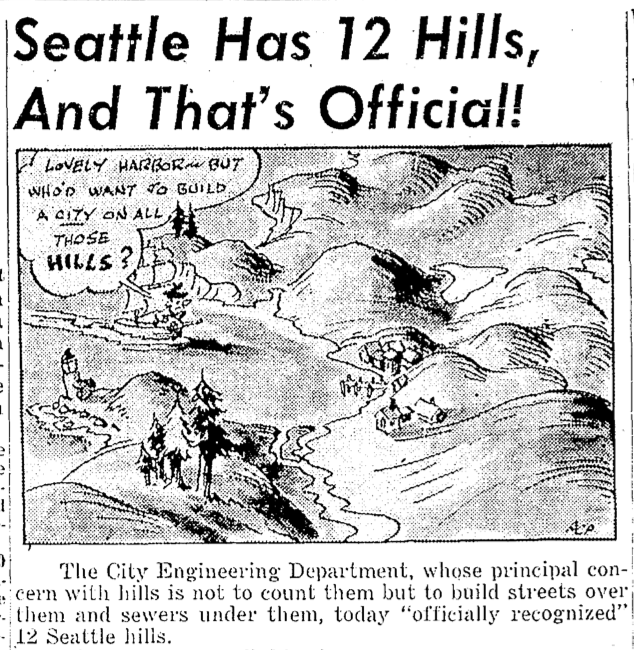“Seattle’s hills have been its pride and they have been its problem; they have given the city distinction and they have stood in the way of progress,” wrote Sophie Frye Bass in her 1947 memoir, When Seattle Was a Village. As the granddaughter of city founder Arthur Denny, Bass was in a good position to witness the early history of Seattle and her book is often credited with popularizing the sentimental notion that Seattle was built on seven hills, just like ancient Rome.

I have heard this topographic claim for as long as I can remember. During my youth, I liked the sound of it; I thought the comparison gave the city an air of distinction. As I matured and became more skeptical, I began to question the details—hills seem to be everywhere—and wondered if some early marketer had invented the idea. Besides, I now view the world through my geocentric eyes and have to look for a more coherent story of Seattle’s underlying topography so I have decided to try and test the theory of the seven hills. Had I been misled as a youth or did we share this hilly quirk with that other city well known for its espresso? And which of our many knolls were the magical seven?
My initial task of naming the seven seemed simple, but proved more challenging than I expected. Friends and family said they had heard the claim but few agreed with Bass, who listed Beacon, Capitol, Denny, First, Queen Anne, Profanity, and Renton. Bass’ first five made most lists but only my mom had heard of Profanity and Renton, also known as Yesler and Second, respectively. Some pinned their hopes on Magnolia and West Seattle, but others favored Mount Baker Ridge, Phinney Ridge, Sunset Hill, or Crown Hill. One overachiever even declared that Seattle is blessed with fifteen hills.
I also talked with someone who questions the entire debate on the seven hills. The late Brewster Denny, a family friend, was Arthur Denny’s great grandson. He expressed a good natured bias toward his aunt telling me, “I don’t see what the controversy is, Sophie was right.”
Whether right or not, Aunt Sophie was not the first to call attention to the hilly heptad. One of the earliest mentions that I could find of seven hills came from the November 6, 1904, issue of the Seattle Times. One Mrs. M.A. Hardy wrote of Seattle “The morning dawns across the waves, At last my eyes can see, The longed for haven of my dreams. The city by the sea, (Like Rome upon her seven hills/In power and grandeur dressed). Like many early histories, articles, and personal reminiscences, Mrs. M. A. Hardy’s poem cited only Seattle’s topographical plenitude, and did not name an ideal seven.

These early voices mostly moan about the problems associated with hills. For example, two early engineers thought that people shouldn’t have to trouble themselves with walking. Instead, they proposed escalators to ferry people and beasts up the slopes. Then there’s legendary City Engineer Reginald Thomson, who thought that the best idea was simply to level the damned things, though being a truly religious man, I doubt he damned them.
Early citizens may not have cottoned on to romantic notions of rocky knolls offering scenic views of majestic mountains, but by Aunt Sophie’s time it had become a raging issue. A letter to the Seattle Times on March 13, 1950, asking for names of the fabled seven, prompted a rain of responses. Hill advocates listed anywhere between five and ten hills, including long lost favorites Dumar, Boeing, Nob, and Pigeon Point. Adding a ray of government clarity, the City Engineering Department officially recognized 12 hills. They included Sophie’s original seven plus West Seattle, Magnolia Bluff, Sunset, Crown, and Phinney Ridge.
For most modern Seattleites, West Seattle and Magnolia have moved into the pantheon of seven, substituting for Profanity and Renton. Some local historians quibble with these two because Magnolia did not officially become part of Seattle until annexation in 1891 and West Seattle until 1907. Despite this “technicality” and the fact that Denny has been regraded to a mere blip, conventional wisdom now lists Beacon, Capitol, Denny, First, Magnolia, Queen Anne, and West Seattle as the Seven Hills of Seattle.
If you want to see the city’s homage to the Seven Hills, you can visit Seven Hills Park on Capitol Hill.
This story on Seven Hills appeared in a different form in my book, The Seattle Street Smart Naturalist.
If you so desire, you can like my geologywriter Facebook page.
There was also a Broadway Hill. In 1895, The Seattle Post-Intelligencer said that City Park was “situated on the highest of the Broadway Hill ridge. For more info. on this see: The Hill With a Future: Seattle’s Capitol Hill 1900-1946
Thanks mom. Always nice to have a fellow historian in the family!
I love the updates and the information is superb. I am however confused as to why Crown, Phinney Ridge, Sunset are not included?
Peter
They didn’t make the original cut because they weren’t part of the city when people first started writing about the idea of seven hills.
David